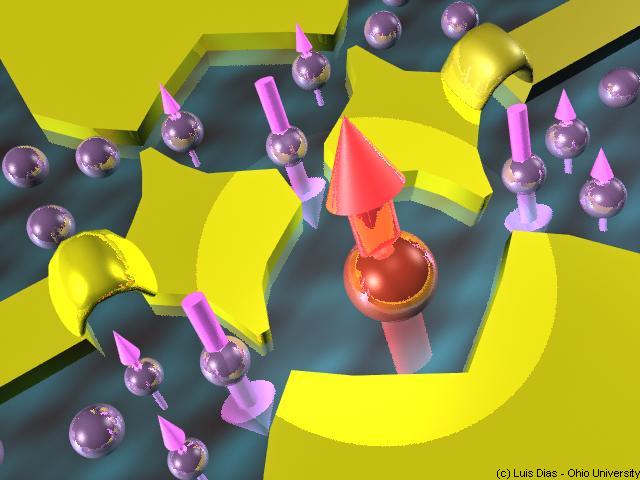
Home
Kondo effect and Numerical
Renormalization-Group
Remarkable
achievements in the development of nano-scale devices
in the last decade provide unique opportunities for research in
nanoelectronic systems. Recent technological developments in both
sample materials and
experimental techniques have made it possible to reach control
over the dynamics of individual electrons in nanodevices such as
single-electron transistors (SETs).
Particular
attention has been devoted to the effect of strong electron-electron
interactions (also
referred to as "strong correlation effects") in the transport
properties of
nanodevices. Electrons can now be confined
and manipulated in a controllable way in semiconductor quantum
dots, scanning tunneling microscopy set-ups and molecular
junctions, allowing for a myriad of single-particle and
many-body effects to be probed in detail.
Prominent among these is
the Kondo
effect, arising from the screening of a local magnetic
moment (such as a single electron spin) by the surrounding
electrons in a continuum, forming a many-body bound state.
The essential physics of the Kondo effect in equilibrium is
captured by quantum impurity models describing a magnetic impurity
coupled to Fermi reservoirs, such as the Kondo model or,
more
generally, the Anderson
model. The formulation of the latter
includes charge fluctuations, thus allowing for the description of
equilibrium transport properties through the impurity. One of the
most accurate schemes for obtaining the low-energy excitation
spectra in these and other quantum impurity models is given by
Kenneth Wilson's Numerical Renormalization Group (NRG) method.
The non-perturbative nature of this
method allows the calculation of
physical
properties (such as spectral functions and magnetization curves)
at arbitrarily low temperatures and excitation energies, precisely
in the region where the Kondo effect is fully developed.
In this sense, the NRG method constitutes a very powerful tool to
explore different effects in transport properties of strongly
correlated systems. In particular, there has been a large interest
on the use of NRG for equilibrium transport calculations in
quantum dot systems.
My intention is to expand the scope of such applications, by
considering different scenarios where the method could be applied.
Kondo effect in QDs and NRG for beginners:
I suggest reading Chapters 2, 3 and 4 of
Michael Sindel's Ph.D. Thesis (Munich, 2004)
A nice review on the Kondo effect in quantum dots:
Kowenhoven,
Glazman Review - Physics World
Essential NRG references:
- Wilson,
RMP 47
773 (1975) - Wilson's original paper on the
method, with a detailed and rigorous discussion of its application to
the Kondo model.
- Krishna-Murthy,
Wilkins & Wilson PRB 21
1003 (1980) - The basic
paper on the NRG calculations for the Anderson Hamiltonian.
-
Bulla,
Costi, Pruschke RMP 80
395 (2008) - A recent and comprehensive review
on the method.
Other relevant references on NRG:
- Wanda Oliveira & Luiz Oliveira PRB 49 11986 (1994) - Describes the useful "z-trick" in the discretization procedure. Very useful for the computation of thermodynamical properties and spectral densities.
- Chen
& Jayaprakash PRB 52
14 436 (1995) - A very nice reference on
non-flat conduction bands. Explains the "trick" to get the
Lanczos algotithm to converge. Without it, the algorithm is quite
unstable.
- Gonzales-Buxton
& Ingersent PRB 57
14 254 (1998) - A comprehensive paper by Kevin
Ingersent's group. Very nice
description of the Lanczos algorithm for the discretization of a
arbitraty conduction-band
- Hofstetter's
DM-NRG method PRL 85
1508 (2000) - Explains the basics of a method
for a more accurate calculation of the Spectral Function for systems
with broken spin degeneracy.
- Other relevant papers coming soon!

